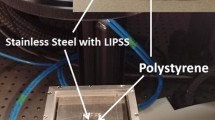Abstract
Because of the micromachining characteristic of excimer laser ablation, the microchannels ablated with this technique on poly(methyl methacrylate) (PMMA) substrate have definite surface roughness. Utilizing this characteristic, the hydrophilicity of PMMA microchannels could be directly modified during fabrication process both by the mechanism of photochemical ablation and the effect of surface roughness. The contact angle is inversely proportional to the surface roughness under ablation with same fluence and could be reduced to 25° by choosing ablation parameters reasonably (7.38 J/cm2, 20 Hz, 10 mm/min). Excimer laser irradiation of PMMA substrates for different irradiation times at fluence below the ablation threshold also results in the surfaces becoming more hydrophilic without any marked change in the surface topography. The contact angle decreases with the increase of irradiation times and finally reaches the saturated status after irradiation for 2,500 times. Under same irradiation times, higher fluence led to PMMA substrates more hydrophilic.






Similar content being viewed by others
References
Cassie ABD, Barter S (1944) Wettability of porous surfaces. Trans Fara Soc 40:546–551
Costela A, García-Moreno I, Florido F et al (1995) Laser ablation of polymeric materials at 157 nm. J Appl Phys 77:2343–2350
Henry AC, Tutt TJ, Galloway M et al (2000) Surface modification of poly(methyl methacrylate) used in the fabrication of microanalytical devices. Anal Chem 72:5331–5337
Hiratsuka A, Muguruma H, Lee KH et al (2004) Organic plasma process for simple and substrate-independent surface modification of polymeric BioMEMS devices. Biosens Bioelectron 19:1667–1672
Hozumi A, Masuda T, Hayashi K et al (2002) Spatially defined surface modification of poly(methyl methacrylate) using 172 nm vacuum ultraviolet light. Langmuir 18:9022–9027
Johnson TJ, Waddell EA, Kramer GW et al (2001) Chemical mapping of hot-embossed and UV-laser-ablated microchannels in poly(methyl methacrylate) using carboxylate specific fluorescent probes. Appl Surf Sci 181:149–159
Lawrence J, Li L (2001) Modification of the wettability characteristics of polymethyl methacrylate (PMMA) by means of CO2, Nd:YAG, excimer and high power diode laser radiation. Mater Sci Eng A 303:142–149
Lee WJ, Lee SE, Kim CG (2006) The mechanical properties of MWNT/PMMA nanocomposites fabricated by modified injection molding. Compos Struct 76:406–410
Liu JK, Pan T, Woolley AT et al (2004) Surface-modified poly(methyl methacrylate) capillary electrophoresis microchips for protein and peptide analysis. Anal Chem 76:6948–6955
Long TM, Prakash S, Shannon MA et al (2006) Water-vapor plasma-based surface activation for trichlorosilane modification of PMMA. Langmuir 22:4104–4109
McCarley RL, Vaidya B, Wei SY et al (2005) Resist-free patterning of surface architectures in polymer-based microanalytical devices. J Am Chem Soc 127:842–843
Prime KL, Whitesides GM (1991) Self-assembled organic monolayers: model systems for studying adsorption of proteins at surfaces. Science 252:1164–1167
Qi H, Chen T, Zuo TC (2006) Surface roughness analysis and improvement of micro-fluidic channel with excimer laser. Microfluidics Nanofluidics 2:357–360
Shah JJ, Geist J, Locascio LE et al (2006) Surface modification of poly (methyl methacrylate) for improved adsorption of wall coating polymers for microchip electrophoresis. Electrophoresis 27:3788–3796
Thomson D, Hayes JP, Thissen H (2004) Protein patterning in polycarbonate microfluidic channels. BioMEMS Nanotechnol, Proc SPIE 5275:161–167
Wei Suying, Vaidya B, Patel AB et al (2005) Photochemically patterned poly(methyl methacrylate) surfaces used in the fabrication of microanalytical devices. J Phys Chem B 109:16988–16996
Wenzel RN (1936) Resistance of solid surfaces to wetting by water. Ind Eng Chem 28:988–994
Wochnowski C, Metev S, Sepold G (2000) UV-laser-assisted modification of the optical properties of PMMA. Appl Surf Sci 154–155:706–711
Acknowledgments
This work was supported by National Natural Science Foundation of China (50335050) and Beijing Natural Science Foundation (3031001) and Funding Project for Academic Human Resources Development in Institutions of Higher Learning under the Jurisdiction of Beijing Municipality. The authors would like to thank Dr. Qi Wei Fellowship (the College of Materials Science and Engineering of Beijing University of Technology) for measurement of contact angle.
Author information
Authors and Affiliations
Corresponding author
Rights and permissions
About this article
Cite this article
Qi, H., Chen, T., Yao, L. et al. Hydrophilicity modification of poly(methyl methacrylate) by excimer laser ablation and irradiation. Microfluid Nanofluid 5, 139–143 (2008). https://doi.org/10.1007/s10404-007-0234-8
Received:
Accepted:
Published:
Issue Date:
DOI: https://doi.org/10.1007/s10404-007-0234-8




